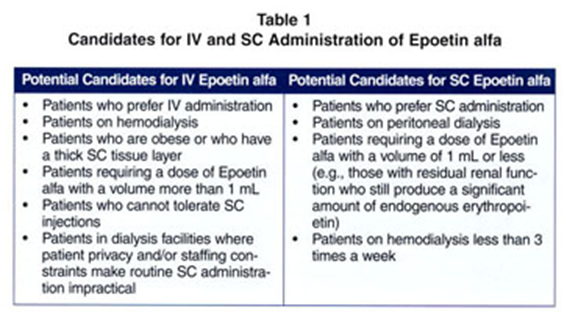A nurse is preparing to administer medication to a client who has a prescription for epoetin alfa. Which of the following routes of administration should the nurse plan to use?
Oral
Intravenous
Inhalation
Transdermal
The Correct Answer is B
Choice A Reason:
Oral is incorrect. Epoetin alfa is not typically administered orally because it would be broken down by digestive enzymes and not absorbed effectively from the gastrointestinal tract.
Choice B Reason:
Intravenous is correct. Epoetin alfa is a medication used to stimulate red blood cell production and is commonly administered intravenously. This route allows for rapid and efficient absorption of the medication into the bloodstream, enabling it to exert its effects effectively.
Choice C Reason:
Inhalation is incorrect. Inhalation is not a route used for epoetin alfa. This medication is intended for systemic effects rather than local effects in the respiratory system.
Choice D Reason:
Transdermal is incorrect. Transdermal administration involves absorption through the skin and is not suitable for epoetin alfa, which needs rapid and direct access to the bloodstream for its action on red blood cell production.

Nursing Test Bank
Naxlex Comprehensive Predictor Exams
Related Questions
Correct Answer is A
Explanation
Choice A Reason:
Apply the patch to a hairless area of the skin is correct. Nitroglycerin patches should be applied to a clean, hairless area of the skin to ensure proper absorption of the medication. Hair can interfere with the patch's adherence and the absorption of nitroglycerin into the bloodstream. The site chosen should be rotated to prevent skin irritation or tolerance development. Commonly used areas include the chest, upper arms, or torso, but it's important to follow specific instructions provided by the healthcare provider.
Choice B Reason:
Apply a 4x4 dressing over the patch is incorrect. Covering the nitroglycerin patch with a dressing may interfere with its absorption and effectiveness. These patches are designed to be applied directly to the skin without covering.
Choice C Reason:
Apply the patch to the same site every 24 hr is incorrect. Repeatedly applying the patch to the same site increases the risk of skin irritation or tolerance to the medication. It's crucial to rotate patch sites to avoid these issues.
Choice D Reason:
Apply the patch to a bony prominence on the chest is incorrect. Nitroglycerin patches should not be placed on bony prominences because these areas can be uncomfortable and may not provide optimal absorption. Instead, they are typically applied to relatively flat, hairless areas of the skin.
Correct Answer is D
Explanation
Choice A Reason:
Bilateral muscle weakness is not typically associated specifically with fluid volume excess. Muscle weakness can result from various causes, such as electrolyte imbalances or certain medical conditions, but it's not a primary manifestation of fluid volume excess.
Choice B Reason:
Thready pulse is not correct. A thready pulse refers to a weak and barely palpable pulse. This is more commonly associated with conditions like shock or reduced cardiac output rather than fluid volume excess.
Choice C Reason:
Decreased bowel sounds is not correct. Reduced or absent bowel sounds may indicate gastrointestinal issues, but they are not a direct manifestation of fluid volume excess. Increased bowel sounds might be more associated with certain types of gastrointestinal disturbances or fluid imbalances, but decreased sounds are not a typical sign of fluid volume excess.
Choice D Reason:
Distended neck veins is correct. In a client experiencing fluid volume excess, distended neck veins can often be observed due to increased venous pressure. This occurs as a result of the body retaining more fluid than it can handle, leading to an increase in blood volume and pressure within the vascular system. This can cause the jugular veins in the neck to appear distended or prominent.

Whether you are a student looking to ace your exams or a practicing nurse seeking to enhance your expertise , our nursing education contents will empower you with the confidence and competence to make a difference in the lives of patients and become a respected leader in the healthcare field.
Visit Naxlex, invest in your future and unlock endless possibilities with our unparalleled nursing education contents today
Report Wrong Answer on the Current Question
Do you disagree with the answer? If yes, what is your expected answer? Explain.
Kindly be descriptive with the issue you are facing.
